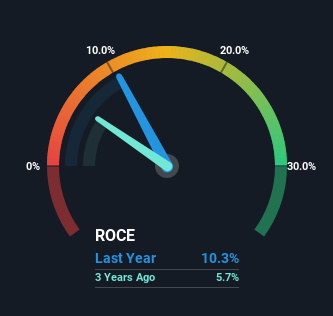- Israel
- /
- Energy Services
- /
- TASE:LAPD
Some Investors May Be Worried About Lapidoth Capital's (TLV:LAPD) Returns On Capital
If we want to find a potential multi-bagger, often there are underlying trends that can provide clues. Firstly, we'll want to see a proven return on capital employed (ROCE) that is increasing, and secondly, an expanding base of capital employed. Put simply, these types of businesses are compounding machines, meaning they are continually reinvesting their earnings at ever-higher rates of return. Having said that, from a first glance at Lapidoth Capital (TLV:LAPD) we aren't jumping out of our chairs at how returns are trending, but let's have a deeper look.
Return On Capital Employed (ROCE): What Is It?
For those that aren't sure what ROCE is, it measures the amount of pre-tax profits a company can generate from the capital employed in its business. The formula for this calculation on Lapidoth Capital is:
Return on Capital Employed = Earnings Before Interest and Tax (EBIT) ÷ (Total Assets - Current Liabilities)
0.10 = ₪423m ÷ (₪7.8b - ₪3.7b) (Based on the trailing twelve months to September 2023).
Therefore, Lapidoth Capital has an ROCE of 10%. On its own, that's a standard return, however it's much better than the 7.0% generated by the Energy Services industry.
View our latest analysis for Lapidoth Capital

Historical performance is a great place to start when researching a stock so above you can see the gauge for Lapidoth Capital's ROCE against it's prior returns. If you want to delve into the historical earnings, revenue and cash flow of Lapidoth Capital, check out these free graphs here.
What Can We Tell From Lapidoth Capital's ROCE Trend?
In terms of Lapidoth Capital's historical ROCE movements, the trend isn't fantastic. Around five years ago the returns on capital were 15%, but since then they've fallen to 10%. Although, given both revenue and the amount of assets employed in the business have increased, it could suggest the company is investing in growth, and the extra capital has led to a short-term reduction in ROCE. And if the increased capital generates additional returns, the business, and thus shareholders, will benefit in the long run.
While on the subject, we noticed that the ratio of current liabilities to total assets has risen to 47%, which has impacted the ROCE. If current liabilities hadn't increased as much as they did, the ROCE could actually be even lower. What this means is that in reality, a rather large portion of the business is being funded by the likes of the company's suppliers or short-term creditors, which can bring some risks of its own.
Our Take On Lapidoth Capital's ROCE
Even though returns on capital have fallen in the short term, we find it promising that revenue and capital employed have both increased for Lapidoth Capital. And the stock has done incredibly well with a 268% return over the last five years, so long term investors are no doubt ecstatic with that result. So should these growth trends continue, we'd be optimistic on the stock going forward.
If you're still interested in Lapidoth Capital it's worth checking out our FREE intrinsic value approximation to see if it's trading at an attractive price in other respects.
If you want to search for solid companies with great earnings, check out this free list of companies with good balance sheets and impressive returns on equity.
New: AI Stock Screener & Alerts
Our new AI Stock Screener scans the market every day to uncover opportunities.
• Dividend Powerhouses (3%+ Yield)
• Undervalued Small Caps with Insider Buying
• High growth Tech and AI Companies
Or build your own from over 50 metrics.
Have feedback on this article? Concerned about the content? Get in touch with us directly. Alternatively, email editorial-team (at) simplywallst.com.
This article by Simply Wall St is general in nature. We provide commentary based on historical data and analyst forecasts only using an unbiased methodology and our articles are not intended to be financial advice. It does not constitute a recommendation to buy or sell any stock, and does not take account of your objectives, or your financial situation. We aim to bring you long-term focused analysis driven by fundamental data. Note that our analysis may not factor in the latest price-sensitive company announcements or qualitative material. Simply Wall St has no position in any stocks mentioned.
About TASE:LAPD
Lapidoth Capital
Provides drilling and related services in Israel, Romania, the United States, Poland, rest of Europe, and internationally.
Excellent balance sheet with proven track record.
Market Insights
Community Narratives



